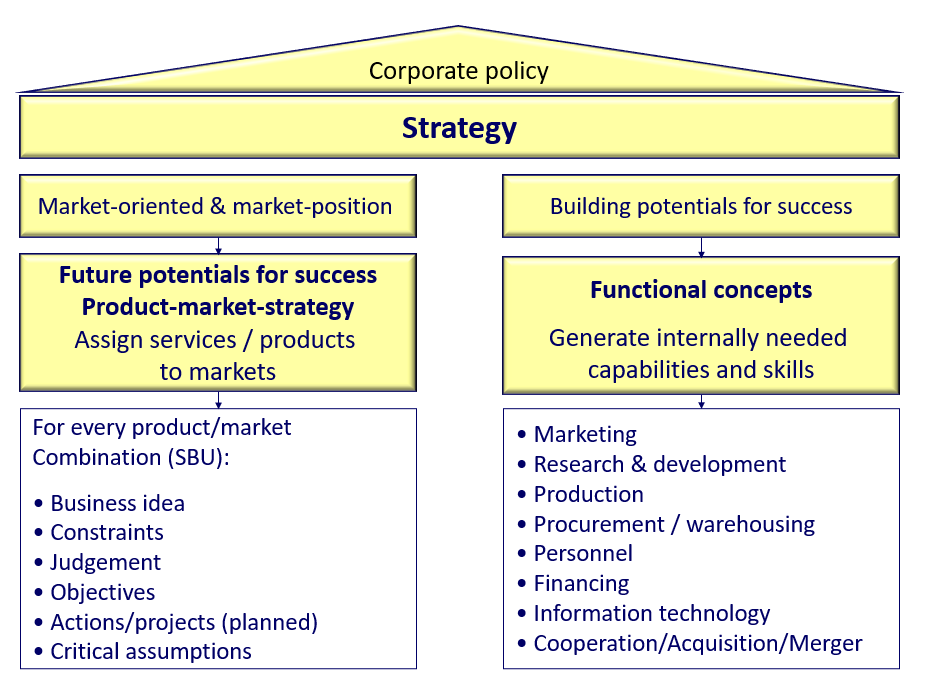Last Updated on March 12, 2024 by Lukas Rieder
Michael Porter (On Competition, 2008) notes that a strategy should describe the unique selling propositions and the market positions to be achieved in the respective market areas with the company’s own offers. This means that an independent strategy must be defined for each product/market combination. Following this definition, objectives, projects and measures must be determined which appear suitable for achieving the desired position operationally.
Unfortunately, the term strategy is nowadays used for almost everything that is associated with planning. This fuzziness in the use of the term leads to uncertainties in management and to poor investments. For this reason, we distinguish between strategies and functional concepts in strategic planning:
Strategy:
Definition of the position to be achieved by independent product/market area and description of the success potentials to be built up or expanded in the areas. This requires the creation of Strategic Business Units (SBUs).
For each product/market strategy, the business idea to be pursued, the general conditions to be considered and the responsible persons assessment of the chances of implementation must be specified. As a basis for subsequent implementation planning, the results to be achieved (sales, turnover, deadlines, contribution margins) must be quantified and the most important actions/projects must be fixed.
In addition, the assumptions made in the preparation of the strategic plan, in particular regarding the development of demand and the actions of competitors, must be documented. These can change during the course of strategy implementation, which could lead to a strategy revision.
To be able to check later on whether the original assumptions still apply when comparing the planned to the actual strategy, the assumptions critical to success must be recorded during strategy formulation. We recommend dividing each strategic plan into six parts (see Controller’s Guide, p. 600):
1 Basic idea: Verbal description of the product/market combination to be created and the objectives to be achieved (sales, turnover, contribution margins) as well as the main competitive advantages and customer benefits from the customer’s point of view.
2 General conditions: Description of the factors and conditions in the environments that are important for strategic success but which cannot be changed by the company itself.
3 Assessment: Assessment of the chances of success of the strategic business area, taking into account possible actions of the competitor strategy and possible SBU’s own defense measures. Documentation of the compliance of the strategic plan with the corporate policy guidelines.
4 Objectives: Definition of the qualitative and quantitative benchmarks to be achieved for each year in the strategic horizon (market shares, product range, quality (from the customer’s point of view), incremental contribution margins). Review by means of a dynamic investment calculation (see the menu position “Free Downloads”, Excel template).
5 Action program: List of projects, market cultivation measures, developments in the sales organization and other actions with milestones, responsibilities, decision-making powers and budgets).
6 Critical assumptions: List of assumptions made for market development. If these assumptions are not met, the strategy must be revised or terminated. Other relevant criteria for the continuation decision may be legal changes, political shifts and new competing products or applications.
To enable strategy implementation, success potentials must usually be newly established or expanded within the company. These success potentials are increasingly planned and realized in the functional areas and also across departments. They form the starting point for the definition of functional concepts.

Functional concepts:
Functional concepts are medium-term objectives and plans of the functional areas for the creation of the success potentials necessary for strategic success. They are defined, for example, for procurement, personnel, production, research and development, information technology (IT) or financing. They create the internal prerequisites for the strategies to be implemented.
For this purpose, plans and projects are created for each area with their results to be achieved, milestones, investment budgets and cost plans and documented in the medium-term planning. Cross-departmental coordination is decisive for success because many results can only be achieved through cooperation. Examples include developing junior managers, developing new applications, centralizing master data maintenance and integrated planning and control systems.
Functional concepts are part of operational multi-year planning because the development of success potentials and integrated processes is often very complex and often takes several years to complete.
